Types of Brown Garden Spiders (With Pictures) – Identification Guide
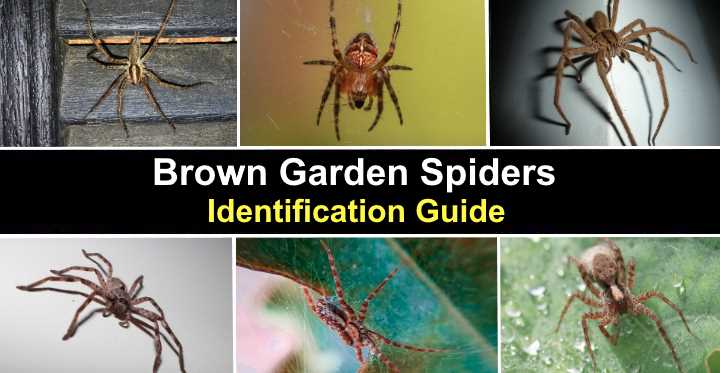
Brown spiders are some of the most common arachnids you find in gardens. Brown garden spiders typically lurk in dark places, like under dead leaves, rocks, boards, and other debris. You can often find brown spiders hiding in the corners of sheds and garages, where they tend to nest in warm, dry places. Seeing a brown spider scurrying in the garden can be terrifying, especially if you think it’s a venomous arachnid that wants to bite you.
Most brown spiders are harmless and play a vital role in a garden’s ecosystem. The outdoor spiders weave intricate webs to capture pests like mosquitoes and flies. Therefore, they help to control insect populations, reducing the need for chemical pesticides.
Identifying brown garden spiders is vital, as some can inflict a painful bite. For example, the brown recluse spider can bite, resulting in a painful inflamed patch as its venom destroys skin tissue.
This article is a guide to the types of brown garden spiders you can find in a front or backyard. Descriptions and pictures of eight-legged brown arachnids will help you identify common spiders in garden landscapes.
Facts About Brown Garden Spiders
Brown garden spiders belong to the arthropod class Arachnida. Like all arachnids, a spider’s anatomy consists of a body divided into two segments—cephalothorax and abdomen. They have eight legs attached to their head and thorax (cephalothorax) part. They usually have eight eyes and mouthparts called chelicerae.
Typically, female spiders are larger and more visible than males, but both spin intricate webs to catch flying insects. Most brown garden spiders are venomous but are not typically aggressive. They tend to bite humans only when threatened. Brown adult spiders usually appear in gardens in late summer and fall in North America.
How to Identify Brown Garden Spiders
Identifying a spider species involves examining its key characteristics. Look at its size, color, distinctive markings, and web design. Some common garden spiders, like the banded garden spider, create a noticeable zigzag design in the web’s center. Other outdoor spiders create funnel or orb webs to catch their prey.
In this article, identifying features of the brown garden spiders refers to adult spiders. The spider measurements are only for their body length, excluding legs. So, some small brown spiders with long legs may appear larger than their body size.
Type of Brown Garden Spiders — Identification Guide (with Pictures)
Let’s examine the identifying features of some common brown garden spiders in more detail.
Cross Orb Weaver (Araneus diadematus)
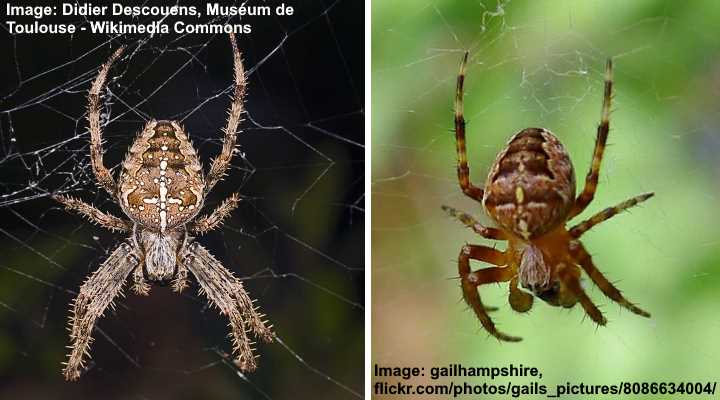
Cross orb weaver spiders: Female (left picture) and male (right)
The cross orb weaver is a distinctive brown spider and one of the most common garden spiders. The spider’s identifying features are its round abdomen, mottled brown patterns, and a prominent white cross near its cephalothorax. It also has darker bands across its abdomen. Female spiders have spiny forelegs and long, banded rear legs.
Also called the European garden spider, the orb weaver has coloration ranging from pale yellow to reddish-brown. The females measure 0.26” to 0.79” (6.5 – 20 mm), and the males are slightly smaller. The whitish cross on their backs is the principal identifying feature of the cross orb weaver.
Female orb weavers spin intricate orb webs to catch flying insects. The harmless brown spiders are primarily found in gardens, fields, and forests, where they can build webs between plants and trees. Cross orb weavers are not aggressive and will typically scurry away if disturbed. They are common in gardens from late summer through fall.
Brown Recluse (Loxosceles reclusa)
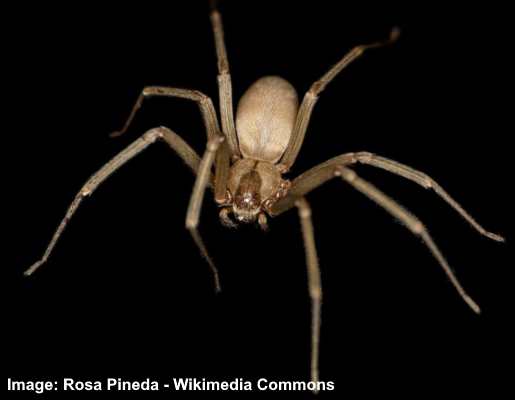
The brown recluse is a venomous spider with light brown body and long legs
The brown recluse is a venomous spider commonly found outside under rocks, leaf litter, woodpiles, and logs. The spider is recognized by its pale brown color and distinctive violin-shaped marking on its cephalothorax. The common brown garden spider lacks patterns on its abdomen and legs, helping to distinguish it from other brown spiders.
Adult female brown recluse spiders measure 0.24” to 0.79” (6 – 20 mm) in length. Its long, spindly legs, light to dark brown color, and violin pattern make it easily recognizable. Despite being a common outdoor spider, brown recluses can enter homes, sheds, cellars, and garages.
Brown recluse spiders are the most common garden spiders in the central and southern regions of the United States. Even though they inflict a nasty bite, they tend to scurry away when disturbed. However, bites usually occur when the spider gets trapped against the skin, such as when putting on clothing or shoes. They are also common brown house spiders.
American Grass Spider (Agelenopsis spp.)
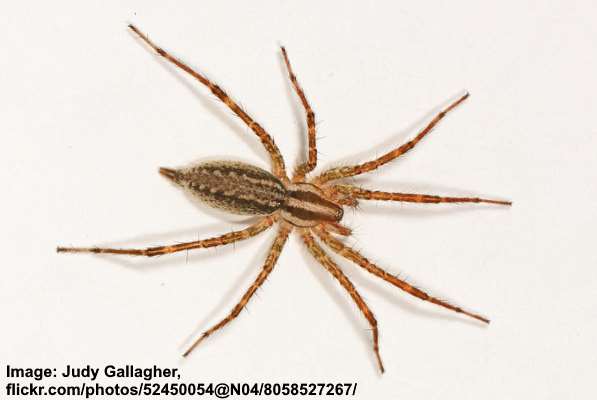
The American grass spider has a light brown body with dark brown stripes and brown patterns on its body
The American grass spider is a common brown spider found in lawns, ornamental grasses, bushes, and gardens. It has a long, slender brown body, long legs, and noticeable dark brown and tan bands on its abdomen and cephalothorax. It’s a funnel web spider that can run quickly in grass and low vegetation.
Brown adult grass spiders measure 0.39” to 0.67” (10 – 17 mm) long, and the males are slightly smaller. These common garden spiders are not harmful or aggressive to humans. They primarily feed on small insects that get caught in their funnel webs. Because the webs of funnel weavers are not sticky, they must run fast to catch their prey.
Grass spiders are beneficial for controlling the population of pests in outdoor areas. You will likely find grass spiders in low bushes, wood piles, woodlands, and grassy garden areas.
Filmy Dome Spider (Neriene radiata)

The filmy dome spider is a type of brown sheet weaver spider common in gardens and wooded areas. The spider has a broad, dark brown middle band with white margins on its bulbous abdomen. Its small head is brown and smaller than its rounded body. It has long, spindly legs compared to its small body size.
The tiny brown filmy dome adult females measure 0.12” to 0.25” (3 – 6 mm) long, while males are slightly smaller.
Filmy dome spiders construct their intricate webs horizontally in low vegetation, such as grass, shrubs, or flowers. It lurks under the web, ready to pounce on prey that lands on it. Filmy dome spiders are not aggressive and pose no threat to humans. They primarily feed on small insects caught in their webs, such as flies, mosquitoes, and gnats.
Hololena

Hololena is a genus of striped brown grass spiders commonly found in gardens throughout North America. The funnel weavers are identified by the rusty-brown bodies with dark bands on either side of the cephalothorax and abdomen. The long, spiny brown legs also have dark brown or black spots.
The female funnel web spiders in the genus Hololena measure 0.34” to 0.47” (9 – 12 mm) long and are larger than the males. These fast-running brown grass spiders are harmless and not aggressive to humans. The funnel web spiders catch prey in their thick, bowl-shaped webs.
Hololena spiders can bite humans when they feel threatened. However, the bites are relatively rare but can result in mild pain and swelling. In yards across North America, you can find these brown garden spiders on low-growing vegetation like small shrubs, ornamental grasses, and lawns.
Little Banded Wolf Spider (Pardosa modica)

The little banded wolf spider is a common brown spider found in gardens. The spider’s identifying features are its dark brown oval body with two blackish lateral bands on its cephalothorax. The spider has long legs covered in tiny black spines. It also has large chelicerae with fangs.
The spider gets its name from its hunting behavior. Instead of spinning webs, the wolf spider actively hunts for prey. Because of this, they tend to have excellent eyesight and fast, rapid movements.
Brown female little banded wolf spiders grow up to 0.27” (7 mm) long. However, their long legs make the male and female wolf spiders appear larger. You will likely find thin-legged wolf spiders in lawns, gardens, and fields. They are most active during the warmer months and may occasionally find their way inside homes and buildings.
Wolf Spider (Lycosid)
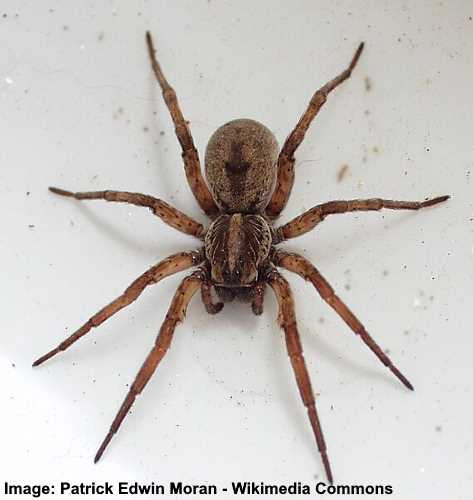
Female wolf spider of the species Hogna lenta
Wolf spiders are a group of brown arachnids commonly found in gardens. The hunting spiders typically have stout, hairy brown bodies, long legs, and eight eyes—two of which are large and prominent. Brown wolf spiders have rounded abdomens, sometimes with a central dark brown band or mottled patterns.
Wolf spiders are excellent hunters with eyesight as good as jumping and huntsman spiders. Wolf spiders get their name from their habit of actively hunting for prey and pouncing on their victims.
These large brown spiders range in size from 0.5” to 2” (13 – 50 mm), with females being larger than males. Wolf spiders are venomous and can bite humans if provoked. The symptoms of bites are mild pain, swelling, and itching.
You can find wolf spiders in various habitats, including grassy areas, underneath rocks or logs, and in burrows. They are active hunters at night and are often seen running across the ground to chase down their prey.
Western Lynx Spider (Oxyopes scalaris)

The western lynx spider is a small, pale brown spider with spiny legs. Distinctive features of the brown spider are its elongated body, large cephalothorax, and light brown and tan mottled pattern on its abdomen. It also has long legs and a compact body, similar to jumping spiders.
Mature female lynx spiders grow 0.15” to 0.6” (4 – 15 mm) long. They are known for their excellent vision and agile hunting skills. You can commonly find these brown spiders in outdoor areas such as gardens, meadows, and forests. It’s most active in spring and early summer.
The lynx spider is beneficial for controlling pest populations, making it a helpful addition to garden ecosystems.
Fishing Spiders (Dolomedes)
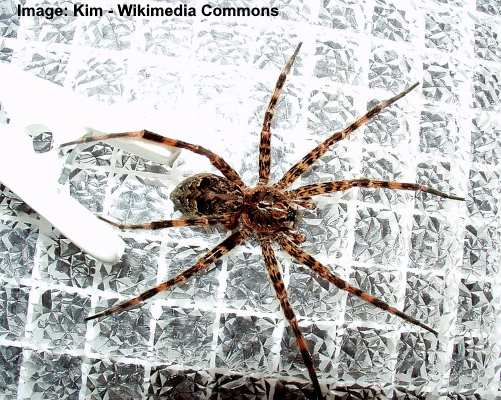
Dark fishing spider (Dolomedes tenebrosus)
Fishing spiders are a group of brown spiders commonly found in gardens with ponds or streams. Characteristic features of the spiders are their mottled brownish-gray patterns, chevron markings on their tear-shaped abdomens, and black bands on their legs. The brown spiders are easily mistaken for large wolf spiders.
Large brown fishing spiders can measure up to 1” (25 mm). However, due to their long legs, they appear larger with a leg span of over 3” (80 mm). A feature of these garden spiders is their ability to dart across water and hunt underwater.
Like most brown spiders in gardens, fishing spiders are not aggressive towards humans and will retreat if approached. They are common outdoor spiders in Texas.
American Nursery Web Spider (Pisaurina mira)
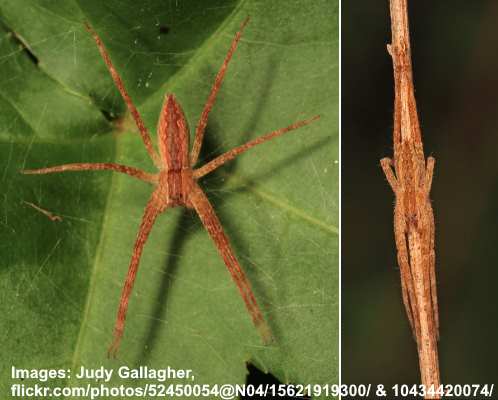
American nursery web spider (Pisaurina mira). Right image: the spider is camouflaged like a stick
The nursery web spider is a type of brown spider commonly on weeds or low shrubs. Identifying features are its dark tan to rusty brown body, eight eyes arranged in two rows, and a dark lateral band on its abdomen. When resting on its web, the spiders have a distinctive star shape.
Female American nursery web spiders are larger than males, measuring 0.47” to 0.74” (12 to 15 mm) long. In Eastern North America, you may see the brown garden spiders in meadows, fields, bushes, and woodland areas. They are common from the Rio Grande Valley of Texas to Central Florida.
Brown Crab Spider (Xysticus cristatus)
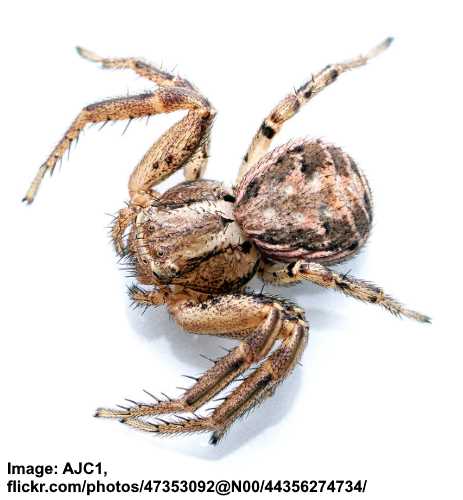
The brown crab spider is easily identified by its coin-shaped abdomen and dark brown to grayish color. Common in gardens with low-growing vegetation, the crab spider has a flat body and eight legs in a crab-like shape. It has white triangular patterns or mid-stripe on its head with a dark brown patch.
Adult brown female crab spiders measure around 0.24” to 0.31” (6 – 8 mm) long. In gardens, the brown crab spiders are commonly found on flowers such as daisies, sunflowers, and goldenrod. The species is generally larger than flower crab spiders.
Woodlouse Spider (Dysdera crocata)

Woodlouse spider is orange and brown spider with an elongated body
The woodlouse spider is a unique rusty-brown smooth spider commonly found in yards under rocks, plant pots, bricks, and log piles. The garden spider has a reddish-brown cephalothorax and legs, a yellowish-brown abdomen, and six eyes. It also has large distinctive chelicerae and a glossy body, making it easy to identify.
As its common name suggests, the hunting spider preys on woodlice, pillbugs, sowbugs, and other small insects. Adult females grow 0.43” to 0.59” (11 – 15 mm) long, and the males are slightly smaller.
You will find these brown spiders in damp areas with decaying wood, as this is a preferred habitat for woodlice.
Texas Brown Tarantula (Aphonopelma hentzi)
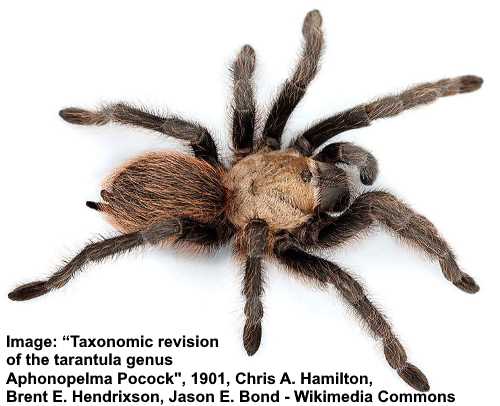
The Texas brown tarantula is a large, fuzzy brown spider common in yards in the Southern United States. Identifying features of the huge spider are its dark brown coloration, hairy appearance, eight robust legs, and large chelicerae. Despite their frightening look, Texas tarantulas are not aggressive. Instead, they are docile, harmless, hairy spiders.
Female tarantulas grow 2” to 2.25” (5 – 5.7 cm) with a leg span of around 5” (13 cm). You typically find Texas brown tarantulas in burrows, grasslands, or under logs and stones.
Like most brown garden spiders, male and female tarantulas can bite when threatened. Their large fangs mean they can puncture the skin, causing pain, swelling, and sometimes secondary infections.
Banded Garden Spider (Argiope trifasciata)

The banded garden spider has yellow, white and brown-black bands on its legs and body
The banded garden spider is a species of brown orb weaver spider with distinctive brown, tan, black, and yellow patterns on its legs and abdomen. The large spider has banded legs, an elongated brown oval abdomen, and black, white, and yellow stripes on its abdomen’s underside.
Female banded garden spiders are smaller than the more common yellow garden spiders (Argiope aurantia). They measure 0.59” to 1” (15 – 25 mm) long. The male spiders are significantly smaller, only growing up to 0.19” (5 mm) long.
You know you have these spiders in your garden by their intricate webs. The female spider spins beautiful and intricate orb webs with a zigzag pattern in the center.
Huntsman spiders (Sparassidae)
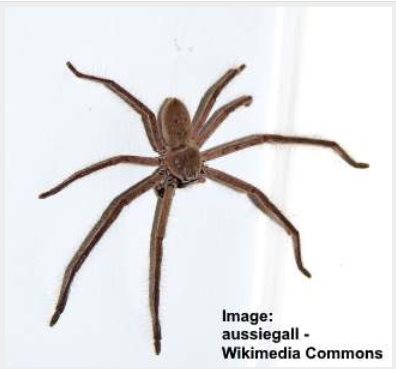
Huntsman spiders have many species and are large with long legs
Huntsman spiders are a brown species of spider with oval abdomens and long, crab-like legs. The brown spider’s identifying features are its long legs covered in spines, brown or tan furry abdomen and head. Although huntsman spiders are typically brown, some spiders in the species have a reddish-brown or gray appearance.
Huntsman spiders are large brown spiders measuring around 1” (25 mm). However, the leg span of adult spiders can be between 3” and 5” (70 – 120 mm). Their large appearance and furry bodies make them easy to confuse for tarantulas.
Barn Spider (Araneus cavaticus)

The barn spider is a common orb weaver with an oval abdomen and yellow and brown coloration. The large spider has a bulbous abdomen with brownish patterns and hairy legs with a banded appearance. The nocturnal brown spiders often live in barns, sheds, patios, and porches. However, they also spin webs on garden vegetation to catch prey at night.
Female barn spiders measure about 0.75” to 1” (20 – 25 mm) long, while the males are smaller. They are active in late summer through fall in the Northeastern United States.
Related articles:
